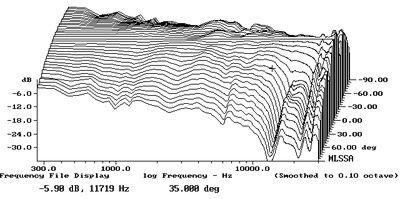| Columns Retired Columns & Blogs |
Infinity Prelude MTS loudspeaker Measurements part 2
As expected from its very narrow front baffle, the Prelude's horizontal dispersion (fig.4) is wide and well-controlled. With the small radiating diameter of the midrange unit, there is no hint of the usual "flare" at the bottom of the tweeter's passband, which usually gives rise to accusations of brightness. The response to the sides of the tweeter axis drops a little more than usual above 7kHz or so, due to the flared waveguide around the tweeter affecting its directivity. This might make the speaker sound slightly mellow in very large rooms.

Fig.4 Infinity Prelude MTS, lateral response family at 50", normalized to response on tweeter axis, from back to front: differences in response 90 degrees-5 degrees off-axis, reference response, differences in response 5 degrees-90 degrees off-axis.
This off-axis, top-octave narrowing of the tweeter's output can also be seen in the vertical plane (fig.5). With the asymmetrical tweeter-midrange layout, the speaker's designers have sensibly arranged for the inevitable crossover-range suckout to appear well above the tweeter axis. And if you compare this graph (which shows only the differences) with fig.3, it looks as though the slight notch in this region actually fills in if you sit a few degrees below the tweeter axis. But sit very low, and the low treble gets a bit peaky.

Fig.5 Infinity Prelude MTS, vertical response family at 50", normalized to response on tweeter axis, from back to front: differences in response 45 degrees-5 degrees above axis, reference response, differences in response 5 degrees-45 degrees below axis.

Fig.6 Infinity Prelude MTS, tweeter-axis step response at 50" (5ms time window, 30kHz bandwidth).
In the time domain, the MTS's step response indicates that all six of the tower's drive-units (four woofers, one midrange, one tweeter) are connected with positive acoustic polarity. The cumulative spectral-decay plot on the tweeter axis (fig.7) is superbly clean, without a hint of resonant behavior from the drive-units other than the ultrasonic tweeter resonance.

Fig.7 Infinity Prelude MTS, cumulative spectral-decay plot at 50" (0.15ms risetime).
As with Infinity's earlier Prelude models that I have measured, the MTS is an extremely competent design in engineering terms. The mystery to me was that I could not find anything that directly correlated with Michael's finding of occasional sibilance, though I do wonder if the upper-midrange forwardness he noted was connected with the speaker's behavior in the vertical plane.
For those interested in how the Prelude MTS performs in a home-theater setting, a review by Joel Brinkley appeared in the July/August 2000 issue of Stereophile Guide to Home Theater.—John Atkinson
- Log in or register to post comments




































